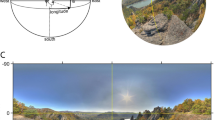Abstract
Any Virtual Reality (VR) immersive experience inherently allows its subjects to choose their own paths of visual attention and/or spatial behavior. If a VR designer employs any system of attentional cues, they might be interested in measuring the system’s effectiveness. Eye tracking (ET) time series data can be used as a visual attention trail and positional time series data can be used as spatial behavior trails. In this paper we are addressing the issue of measuring inter-subject dependence in visual attention and spatial behavior. We are arguing why recently developed distance correlation coefficient [1, 2] might be both a proper and convenient choice to either measure the inter-subject dependence or test for the inter-subject independence in visual and behavioral data recorded during a VR experience.
Access this chapter
Tax calculation will be finalised at checkout
Purchases are for personal use only
Similar content being viewed by others
References
Szekely, G.J., Rizzo, M.L., Bakirov, N.K., Nail, K.: Measuring and testing dependence by correlation of distances. Ann. Stat. 35, 2769–2794 (2007)
Szekely, G.J., Rizzo, M.L.: Brownian distance covariance. Ann. Appl. Stat. 3, 1236–1265 (2009)
Lowood, H.E.: Virtual Reality (2018). https://www.britannica.com/technology/virtual-reality
Sutherland, I.E.: A head-mounted three dimensional display. In: AFIPS Fall Joint computer Conference, pp. 757–764. ACM, New York (1968)
Fox, J., Arena, D., Bailenson, J.N.: Virtual reality: a survival guide for the social scientist. J. Media Psychol. Ger. 21, 95–113 (2009)
Fisher, W.R.: Narration as a human communication paradigm: the case of public moral argument. Commun. Monogr. 51, 1–22 (1984)
Aylett, R., Louchart, S.: Towards a narrative theory of virtual reality. Virtual Real. 7, 2–9 (2003)
Godde, M., Gabler, F., Siegmund, D, Braun, A.: Cinematic narration in VR - rethinking film conventions for 360 Degrees. In: Chen, J., Fragomeni, G. (eds.) VAMR 2018. LNCS, vol. 10910, pp. 184–201. Springer, Cham (2018)
Duchowski, A.T.: Eye Tracking Methodology: Theory and Practice. Springer, Berlin (2007)
Clark, M.: A comparison of correlation measures. Technical report, University of Notre Dame (2013)
de Santos, S.S., Takahashi, D.Y., Nakata, A., Fujita, A.: A comparative study of statistical methods used to identify dependencies between gene expression signals. Brief. Bioinform. 15, 906–918 (2014)
Davis, R.A., Matsui, M., Mikosch, T., Wan, P.: Applications of distance correlation to time series. Bernoulli 24, 3087–3116 (2018)
Szekely, G.J., Rizzo, M.L.: Energy statistics: a class of statistics based on distances. J. Stat. Plan. Infer. 143, 1249–1272 (2013)
Szekely, G.J., Rizzo, M.L.: The energy of data. Ann. Rev. Stat. Appl. 4, 447–479 (2017)
Fan, Y., Lafaye de Micheaux, P., Penev, S., Salopek, D.: Multivariate nonparametric test of independence. J. Multivar. Anal. 153, 189–210 (2017)
Rizzo, M.L., Szekely G.J.: energy: E-statistics: multivariate inference via the energy of data. R package version 1.7-5 (2018). https://CRAN.R-project.org/package=energy
Lafaye de Micheaux P., Bilodeau, M.: Software: R Package, IndependeceTests, Version 0.2 (2012). https://CRAN.R-project.org/package=IndependenceTests
R Core Team: R: A Language and Environment for Statistical Computing, Vienna, Austria (2018). https://www.R-project.org
Author information
Authors and Affiliations
Corresponding author
Editor information
Editors and Affiliations
Rights and permissions
Copyright information
© 2019 Springer Nature Switzerland AG
About this paper
Cite this paper
Kobylinski, P., Pochwatko, G., Biele, C. (2019). VR Experience from Data Science Point of View: How to Measure Inter-subject Dependence in Visual Attention and Spatial Behavior. In: Karwowski, W., Ahram, T. (eds) Intelligent Human Systems Integration 2019. IHSI 2019. Advances in Intelligent Systems and Computing, vol 903. Springer, Cham. https://doi.org/10.1007/978-3-030-11051-2_60
Download citation
DOI: https://doi.org/10.1007/978-3-030-11051-2_60
Published:
Publisher Name: Springer, Cham
Print ISBN: 978-3-030-11050-5
Online ISBN: 978-3-030-11051-2
eBook Packages: Intelligent Technologies and RoboticsIntelligent Technologies and Robotics (R0)




